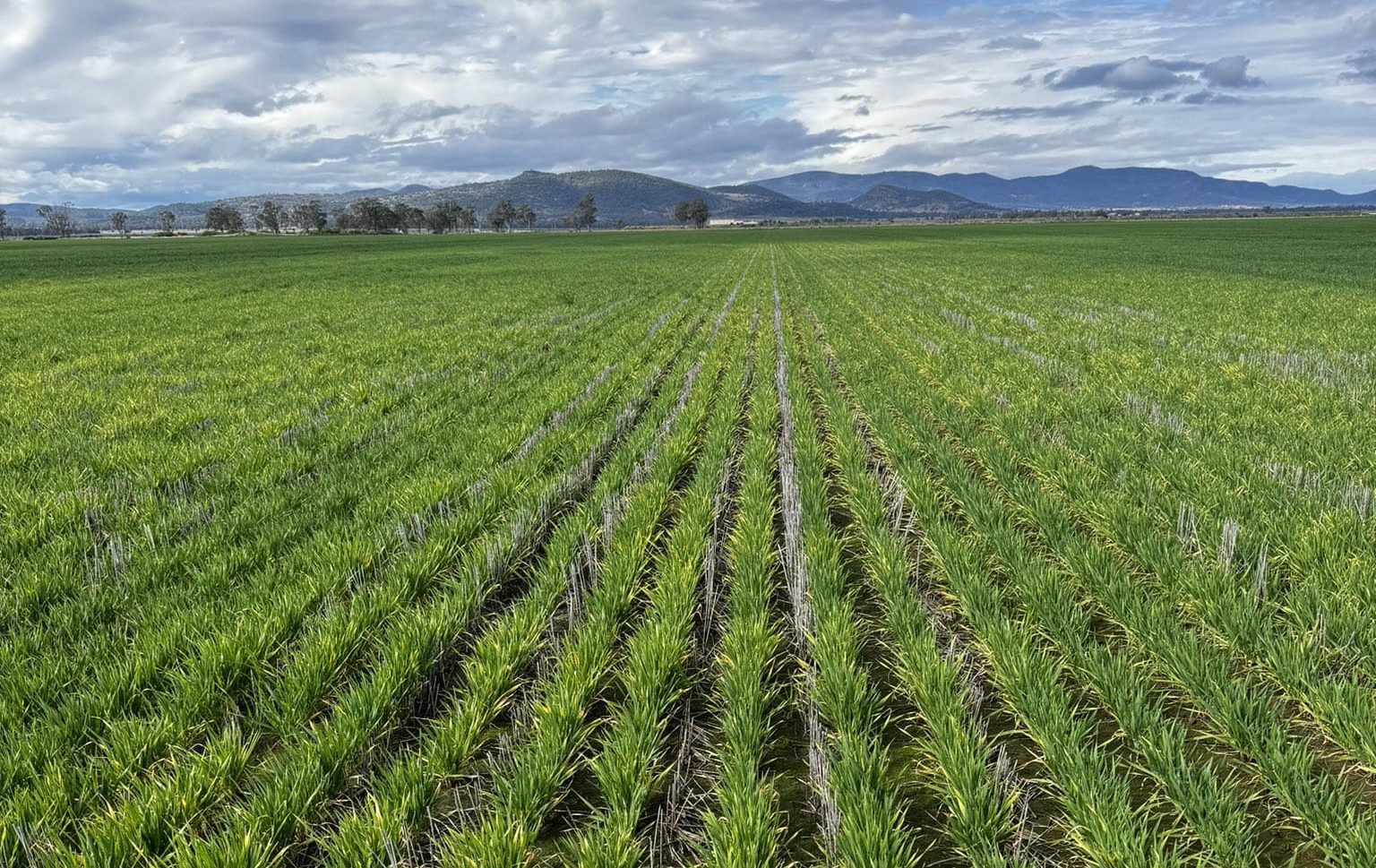
Many northern crops, like this one on the Liverpool Plains of NSW, are on track for above-average yields provided winter does not bring too much more rain. Photo: Stephen Gibson.
FEED wheat and barley has traded sideways to firmer in the past week as rain creates a few logistics headaches in the north, and unseasonal demand from sheep producers kicks up values in the south.
Rain in the past week in most cropping and mixed-farming areas of South Australia and Victoria, coupled with patchy rain in New South Wales, has been ideal for winter cereals, pulses and canola.
However, a sizeable feed deficit stretching from the eastern Riverina of NSW to the South East of SA remains in place as soil, overnight and maximum temperatures hit their annual low to rule out the possibility of pasture growth in coming weeks.
| Prompt | Jun 27 | New crop | June 27 | |
| Barley Downs | $395 | $390 | $360 | $360 |
| ASW Downs | $390 | $390 | $380 | $368 |
| Sorghum Downs | $350 | $348 | $340 | $330 |
| Barley Melbourne | $352 | $350 | $330 | $340 |
| ASW Melbourne | $372 | $360 | $355 | $370 |
Table 1: Indicative prices in Australian dollars per tonne.
North firms
Patchy rain in southern Queensland and northern NSW has created some short-lived logistics headaches for those looking to load grain on farm.
This has some consumer shorts pop up in the market to lift values for barley by around $5 per tonne.
Consumers are now looking to cover the last chunk of current-crop requirements ahead of the barley harvest which is expected to start in October.
Wheat and barley crops in southern Qld and northern NSW are generally looking at above-average yield potential, helped by the La Niña Watch status issued on June 25 in the Bureau of Meteorology’s latest Climate Driver Update.
Smithfield Cattle Co commodity buyer Brett Carsburg said this does not dispel uncertainty for consumers about how big the crop will be, or when it will arrive.
“There could be frost coming, which will impact yield, and if there’s a wet September, that will slow the crop down.
“There are a fair few things in the air that consumers have to think of.”
Barley is being brought by road from central and northern NSW now that stocks in the Qld-NSW border and Moree districts have run down.
“Barley is thinly traded; wheat is easier to access.”
NSW also received patchy rain in the week to today, with higher registrations including: Condobolin 21mm; Grenfell 15mm; Narrabri 12mm; Parkes 27mm, and Quirindi 17mm.
On cottonseed, Woodside Commodities managing director Hamish Steele-Park said cottonseed has traded sideways in the past week.
“The fall in cottonseed values over the past month has encouraged some domestic buying, and export demand remains steady,” Mr Steele-Park said.
Southern Qld’s delivered Downs market is sitting at $500-$505/t, while seed ex gin is trading at around $460/t in the Gwydir Valley, and $450/t in the Namoi.
In southern NSW, ex gin cottonseed is trading at around $465/t.
South gets welcome rain
Up to 30mm of much-needed rain has fallen in Victoria’s Western District this week, and much of the state’s key grain-growing areas of the Mallee and Wimmera have received 5-10mm.
Amid the depths of winter, and a series of frosts, no pasture growth can be expected until late August, and producers are continuing to supplementary feed sheep that normally graze their way through winter.
Reid Stockfeeds trading manager Justin Fay said increased demand from sheep producers, on top of beef and dairy cattle requirements, is boosting up-country grain use to unusually high levels for this time of year.
“At our Camperdown pellet mill, we are normally scaling down production of sheep pellets, but we’ve had to increase our capacity because of the dry conditions,” Mr Fay said.
“Among the main mills in the Western District there’s a lot of competition.”
Mr Fay said mixed farmers who can normally run stock on paddock feed, plus dairying and beef demand, were all adding to unseasonal demand for the region.
“Everyone wants to get hold of what’s in the area first.”
Corn, now priced at around $20-$25/t above SFW wheat, is readily available from northern Vic and the far south of NSW, and is experiencing hot grazier demand.
“Sheep producers in the past have not been interested in corn, and now there’s an abundance of interest coming from them.”
Barley is also on the shopping list for graziers, who are facing competition from exporters looking to fill containers and cargo holds.
Forward selling of new-crop remains thin in the southern market, as growers and traders look for conditions to consolidate before they commit to volume.
“There’s not much grower selling activity on the new crop; we are thinking that will increase over next two weeks if more rain comes as forecast.”
Southern NSW largely missed out on the week’s rain, and some livestock producers in the Riverina are buying in hay and grain to supplementary feed sheep.


HAVE YOUR SAY